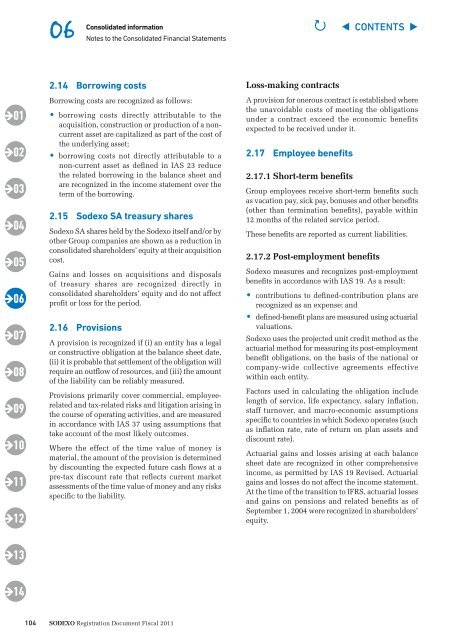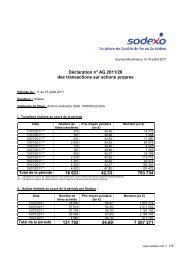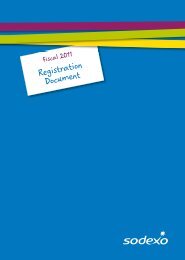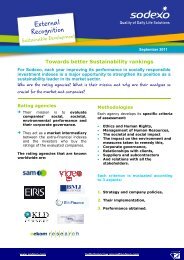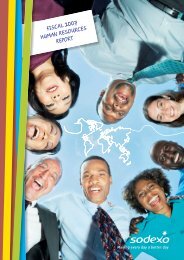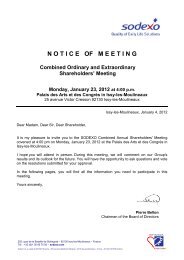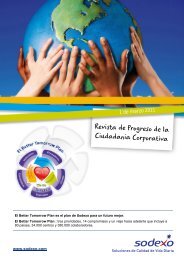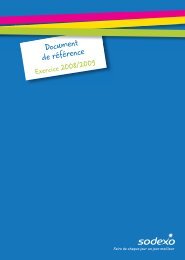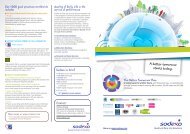Registration Document
Registration Document
Registration Document
You also want an ePaper? Increase the reach of your titles
YUMPU automatically turns print PDFs into web optimized ePapers that Google loves.
01<br />
02<br />
03<br />
04<br />
05<br />
06<br />
07<br />
08<br />
09<br />
10<br />
11<br />
12<br />
13<br />
14<br />
104<br />
06<br />
Consolidated information<br />
Notes to the Consolidated Financial Statements<br />
2.14 Borrowing costs<br />
Borrowing costs are recognized as follows:<br />
• borrowing costs directly attributable to the<br />
acquisition, construction or production of a noncurrent<br />
asset are capitalized as part of the cost of<br />
the underlying asset;<br />
• borrowing costs not directly attributable to a<br />
non-current asset as defined in IAS 23 reduce<br />
the related borrowing in the balance sheet and<br />
are recognized in the income statement over the<br />
term of the borrowing.<br />
2.15 Sodexo SA treasury shares<br />
Sodexo SA shares held by the Sodexo itself and/or by<br />
other Group companies are shown as a reduction in<br />
consolidated shareholders’ equity at their acquisition<br />
cost.<br />
Gains and losses on acquisitions and disposals<br />
of treasury shares are recognized directly in<br />
consolidated shareholders’ equity and do not affect<br />
profit or loss for the period.<br />
2.16 Provisions<br />
A provision is recognized if (i) an entity has a legal<br />
or constructive obligation at the balance sheet date,<br />
(ii) it is probable that settlement of the obligation will<br />
require an outflow of resources, and (iii) the amount<br />
of the liability can be reliably measured.<br />
Provisions primarily cover commercial, employeerelated<br />
and tax-related risks and litigation arising in<br />
the course of operating activities, and are measured<br />
in accordance with IAS 37 using assumptions that<br />
take account of the most likely outcomes.<br />
Where the effect of the time value of money is<br />
material, the amount of the provision is determined<br />
by discounting the expected future cash flows at a<br />
pre-tax discount rate that reflects current market<br />
assessments of the time value of money and any risks<br />
specific to the liability.<br />
Sodexo <strong>Registration</strong> <strong>Document</strong> Fiscal 2011<br />
Loss-making contracts<br />
A provision for onerous contract is established where<br />
the unavoidable costs of meeting the obligations<br />
under a contract exceed the economic benefits<br />
expected to be received under it.<br />
2.17 Employee benefits<br />
2.17.1 Short-term benefits<br />
P ◀ CONTENTS ▶<br />
Group employees receive short-term benefits such<br />
as vacation pay, sick pay, bonuses and other benefits<br />
(other than termination benefits), payable within<br />
12 months of the related service period.<br />
These benefits are reported as current liabilities.<br />
2.17.2 Post-employment benefits<br />
Sodexo measures and recognizes post-employment<br />
benefits in accordance with IAS 19. As a result:<br />
• contributions to defined-contribution plans are<br />
recognized as an expense; and<br />
• defined-benefit plans are measured using actuarial<br />
valuations.<br />
Sodexo uses the projected unit credit method as the<br />
actuarial method for measuring its post-employment<br />
benefit obligations, on the basis of the national or<br />
company-wide collective agreements effective<br />
within each entity.<br />
Factors used in calculating the obligation include<br />
length of service, life expectancy, salary inflation,<br />
staff turnover, and macro-economic assumptions<br />
specific to countries in which Sodexo operates (such<br />
as inflation rate, rate of return on plan assets and<br />
discount rate).<br />
Actuarial gains and losses arising at each balance<br />
sheet date are recognized in other comprehensive<br />
income, as permitted by IAS 19 Revised. Actuarial<br />
gains and losses do not affect the income statement.<br />
At the time of the transition to IFRS, actuarial losses<br />
and gains on pensions and related benefits as of<br />
September 1, 2004 were recognized in shareholders’<br />
equity.


